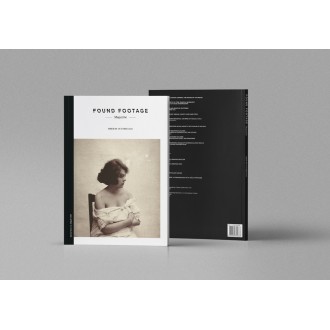Aucun produit
Les prix sont TTC
Produit ajouté au panier avec succès
Il y a 0 produits dans votre panier. Il y a 1 produit dans votre panier.
Found Footage Magazine Issue 8 Octobre 2022
 Agrandir l'image
Agrandir l'image
Numéro 8 de Found Footage Magazine, qui est un journal des études cinématographiques distribués dans le monde entier. Il offre un contenu théorique, analytique et informatif sur les pratiques des images cinématographiques trouvés. Texte en anglais avec des photos en couleur.
Nouveau
FFM comble le vide crée par le fait qu'il n'y a jamais, jusqu'à maintenant, aucun lieu d'échange pour la collection et le partage d'informations, la pensée critique et la discussion sur le cinéma de found footage incluant toutes ses manifestations : cinéma de recyclage, film-essai, film de collage, film de compilation, films d'archives, mash-up ...
FFM accueille une sélection d'articles et des sections destinées à explorer les questions éthiques, politiques, formelles et le contenu relatif à la culture du cinéma de recylage : des monographies, des essais interdisciplinaires, des interviews et des tribunes concernant l'univers éclectique de la réalisation de found footage.
Au Sommaire :
Special on Abigail Child
Abigail Child: We cannot control the pacing of this movie, by Gracia Ramírez
Watching an Abigail Child film for the first time feels like being bombed, tricked and tickled all at once. She interweaves seemingly unending arrays of stimuli drawn from bottomless piles of culture, all sources levelled up. She arranges them in sequences and submits them to layering, constant interruptions and repetitions, like someone tuning the radio, or hopping back and forth between TV channels. Sometimes there is synchrony between sound and image, or some continuity in the ordering of space and time—conventional cinematic cues that prompt the mind to search for meaning, recognize patterns and anticipate effects. But before we get too comfortable and savvy, Child thwarts those expectations and forces us to think again. Over the last forty years, she has used her multiple creative practices to explore meaning and culture in both serious and playful ways. Her work started to break new ground in the 1980s, engaging with the cultural voracity of the all-consuming eyes and ears of the multichannel TV generation, and with the DIY attitude and wholesale rejections of punk.
Through Child’s work we can see ways in which ideas, texts and audiovisual images are adopted, adapted and shared in popular culture, resulting in a sustained argument about how culture is comprised of a never-ending process of circulation and connection.
‘I want to speak with my time’ radical biography in Abigail Ahild’s Acts and Intermissions, by Jeffrey Skoller
Poetic questions and empathic ruptures: The Future Is Behind You, by Maureen Turim
The Suburban Trilogy: Abigail Child’s Cake and Steak, by Rachel Garfield
A little of the transcendental universe of Abigail Child, an interview by Camilla Margarida
ESSAYS
Stan VanDerBeek's Danse Macabre: Found sound, appropriated music, and rehearing, by Michael Betancourt
Into the Unknown known: Images of depersonalized people in post-socialist found footage films, by Lukas Brasiskis
Re-Enacting the Archives in Sam Ashby's The Colour of His Hair, by Matthew LaPaglia
American History Recontextualized: James Benning's American Dreams (Lost and Found), by Theodore Xenophontos
BOOK REVIEWS
Making Images Move: Handmade Cinema and the Other Arts, by César Ustarroz
Persistent Images: Encountering Film History in Contemporary Cinema, by Matthew Cole Levine
DÉMONTAGE: WHITE AFRO, by Akosua Adoma Owusu
| Format | revue, 30x21x1, photos en couleur |
| Langue(s) | anglais |
| Pages | 142 |
| Editeur | César Ustarroz FOUND FOOTAGE MAGAZINE |


